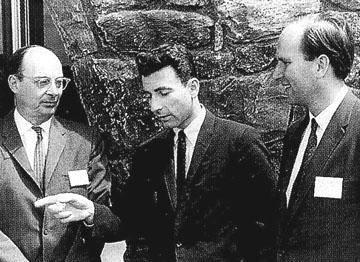
|
April 4, 2007 |
Symposium Marks 50 Years of BCS Theory of Superconductivity
Five Nobel Prize-winning physicists join the chief technology officer of American Superconductor and other researchers to discuss the nature of superconductivity, its broad scientific utility and current applications to energy transmission, transportation and computing. Public lectures and a panel discussion on Thursday, April 12, the first day of the symposium, will help celebrate the 50th anniversary of the BCS theory of superconductivity. | |||
|
Brown University Home |
PROVIDENCE, R.I. [Brown University] — The year 2007 marks the 50th anniversary of the BCS (Bardeen, Cooper, Schrieffer) theory of superconductivity. In celebration, 60 of the world’s brightest minds in quantum physics, spintronics, and condensed matter physics will gather at Brown University on April 12 and 13 for a symposium titled “The BCS Theory of Superconductivity.” Five Nobel Prize winners will participate in the symposium and give public lectures on April 12. On April 13, the symposium speakers include several rising stars, who will focus on some of the most challenging questions facing physicists today.  A sturdy and useful theoretical tool “The creation and teaching of new knowledge is among the highest aims in research universities,” said Ruth J. Simmons, president of Brown University. “The curiosity, insight and dedication that Leon Cooper brought to the mystery of superconductivity has demonstrated well to students and colleagues in physics, neuroscience and beyond how inspiring such an achievement can be on a college campus.” In addition to the scientific lectures, researchers will offer a series of public lectures and panels on the afternoon of April 12 in the Salomon Center for Teaching, located on The College Green. A schedule of speakers is included below and at the physics Web site. Superconductivity – the abrupt loss of electrical resistance at very low temperatures in certain materials – was discovered in 1911 but remained a mystery until 1957. In that year, John Bardeen and Robert Schrieffer proposed an explanation that relied on Leon Cooper’s theory of electron pairing. In 1972 the Nobel Prize Committee recognized the success of BCS theory with a Nobel Prize. The BCS theory provided a unifying explanation for the bewildering behavior of superconductive materials. In the years since 1957, that theory has opened a new field of physics and revealed an approach to complexity that has proved useful many disparate areas of science. “The BCS theory provided a robust and broadly applicable explanation for a problem that many physicists considered unapproachable,” said Chung-I Tan, professor of physics and chair of Brown’s Department of Physics. “The resolution to the puzzle of superconductivity led to a paradigm shift in our understanding of quantum principles and the symmetries of physical laws. The symposium celebrates that achievement by gathering together physicists who are working on some of today’s most daunting problems.” Cooper’s insight into the coordination of electrons allowed the team to discover an elegant solution to a problem that had been forbiddingly complex. Today, the BCS theory is considered one of the sturdiest and most useful tools for explaining a wide variety of physical phenomena, including those in condensed matter physics and in many seemingly unrelated fields. Superconductors have the potential to revolutionize the transmission of electrical power, transportation and even computers, making the world safer, quieter and more efficient. Highly efficient maglev trains speed cross-continent powered by superconductive magnets, and today’s high-temperature superconductors can transmit 150 times more power than conventional copper wires. A conference Web site provides additional information on the scientific conference and the public lectures. Editors: Brown University has a fiber link television studio available for domestic and international live and taped interviews and maintains an ISDN line for radio interviews. For more information, call the Office of Media Relations at (401) 863-2476. Superconductivity: From Mystery to Mastery Public Lectures and Panels 2 p.m. 3 p.m 4:30 p.m. About the Speakers Leon Cooper, Brown University, was awarded the 1972 Nobel Prize in physics for his central role in describing the BCS theory to explain superconductivity. Wolfgang Ketterle, MIT, won the 2001 Nobel Prize in physics for the achievement of a long –theorized state of matter known as a Bose-Einstein condensate. Anthony Leggett, University of Illinois, was awarded the 2003 Nobel Prize in physics for 2003, for pioneering contributions to the theory of superconductors and superfluids. Frank Wilczek, MIT, is considered one of the world’s preeminent theoretical physicists. The inventor of quantum chromodynamics, Wilczek won the 2004 Nobel Prize in physics for the discovery of asymptotic freedom in the theory of the strong interaction. Alexis Malozemoff, chief technical officer, American Superconductor. AMSC is the world’s leading vendor of high-temperature superconductor (HTS) wire and large rotating superconductor machinery. Recognized for his pioneering work in the field of superconductivity, Malozemoff leads the research and development effort for the company, turning the promise of superconducting materials into reality. Charles P. Slichter, University of Illinois at Urbana-Champaign, is one of the world’s top research scientists in the area of magnetic resonance and has been a leading innovator applying resonance techniques to understanding the structure of matter. David Lee, Cornell University, was awarded the 1996 Nobel Prize for work on understanding the quantum properties of superfluid helium-3. ###### | |||